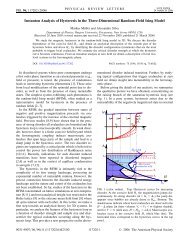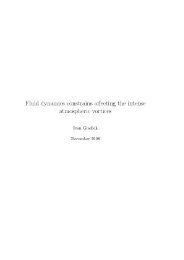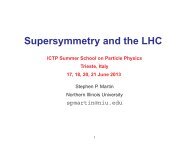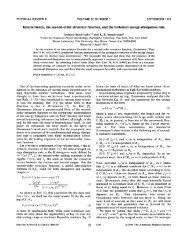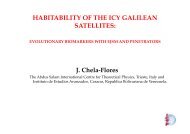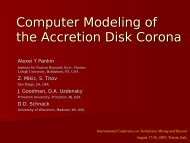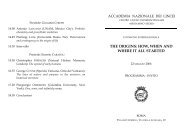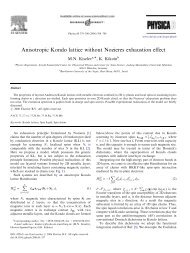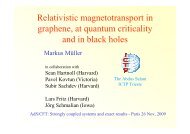Create successful ePaper yourself
Turn your PDF publications into a flip-book with our unique Google optimized e-Paper software.
Worksh<strong>op</strong> on theoretical aspects<br />
of neutrino masses and mixing<br />
<strong>ICTP</strong>, Trieste, Italy<br />
September 17 – 23, 2012
Ongoing progress
eaking<br />
T2K 90%<br />
Fogli et al, 1<br />
Daya Bay, 1<br />
Double Chooz, 1<br />
QLC<br />
RENO, 1<br />
0.0 0.05 0.10 0.15 0.20 0.25 0.30 0.35 0.40<br />
sin 2 13<br />
mass ratio
d 23 = ½ - sin 2 23<br />
the key to ( probe)<br />
understand the<br />
underlying physics<br />
NH<br />
MINOS, 1<br />
symmetry<br />
violation<br />
Connection to<br />
1-3 mixing<br />
Quark -Lepton<br />
Complementarity<br />
Fogli et al, 1<br />
SK, 90%<br />
0.30 0.35 0.40 0.45 0.50 0.55 0.60 0.65 0.70<br />
23 ~ /2 - V cb<br />
sin 2 23
SK (NH), 90%<br />
SK (IH), 90%<br />
Fogli et al, 1<br />
MINOS,<br />
1<br />
0.30 0.35 0.40 0.45 0.50 0.55 0.60 0.65 0.70<br />
sin 2 23<br />
QLC
sin 2 13 ~ 0.022<br />
sin 2 13 =<br />
O(1)<br />
m 21 2<br />
m 32 2<br />
``Naturalness’’ of mass matrix<br />
~ ½ sin 2 C Quark Lepton Complementarity<br />
~ ½cos 2 2 23 - symmetry violation<br />
12<br />
Mixing anarchy<br />
Self-complementarity<br />
The same 1-3 mixing with completely different implications
sin 2 13~ ½sin 2 C<br />
Follows from<br />
permutation of<br />
matrices<br />
From charged<br />
leptons<br />
13~ ½ c<br />
First obtained in the context of<br />
Quark-Lepton Complementarity<br />
U 12 ( c) U 23( /2)<br />
Permutation - to reduce the lepton<br />
mixing matrix to the standard form<br />
Maximal from<br />
neutrinos<br />
H. Minakata, A Y S<br />
Related to smallness<br />
of mass
m 2 31 - m 2 31<br />
Resonance in the antineutrino<br />
channel> V -V
MASS<br />
3<br />
2<br />
1<br />
Normal mass hierarchy<br />
m 2 32<br />
m 2 21<br />
?<br />
FLAVOR FLAVOR<br />
Two large mixings<br />
m 2 32 = 2.3 x 10 -3 eV 2<br />
m 2 21 = 8 x 10 -5 eV 2<br />
MASS<br />
2<br />
1<br />
3<br />
e<br />
Inverted mass hierarchy<br />
m 2 21<br />
m 2 23
Precision IceCube Next Generation Upgrade<br />
Denser array<br />
20 new strings (~60 DOMs each)<br />
in 30 MTon DeepCore volume<br />
Few GeV threshold in inner<br />
10 Mton volume<br />
Energy resolution ~ 3 GeV<br />
Existing IceCube strings<br />
Existing DeepCore strings<br />
New PINGU-I strings<br />
125 m<br />
PINGU v2
~ 1/E0.5 = 0.2E Degeneracy
G. L. Fogli<br />
First glimpses?<br />
T . Yanagida<br />
Neutrinoantineutrino<br />
asymmery<br />
CP ~ /2 +/- 0.02<br />
Third way<br />
Key measurement:<br />
amplitudes of the<br />
- oscillations<br />
due to solar and<br />
atmospheric mass<br />
splittings<br />
Do we have predictions for the phase in quark sector?<br />
Why do we think that we can predict leptonic mixing?<br />
Again because of neutrinos are special ? Symmetries?
In the first<br />
approximation<br />
U tbm =<br />
- maximal 2-3 mixing<br />
- zero 1-3 mixing<br />
- no CP-violation<br />
- sin 2 12 = 1/3<br />
Symmetry from mixing matrix<br />
2/3 1/3 0<br />
- 1/6 1/3 - 1/2<br />
- 1/6 1/3 1/2<br />
U tbm = U 23( /4) U 12<br />
L. Wolfenstein<br />
P. F. Harrison<br />
D. H. Perkins<br />
W. G. Scott<br />
3 is bi-maximally mixed<br />
2 is tri-maximally mixed<br />
Uncertainty related<br />
to sign of 2-3 mixing:<br />
23 =
Mixing appears as a result of different ways of the flavor<br />
symmetry breaking in neutrino and charged lepton sectors<br />
Residual<br />
symmetries<br />
G l<br />
M l<br />
diagonal<br />
G f<br />
G<br />
M<br />
TBM-type<br />
the splitting originates from different flavor assignments of<br />
the RH components of N c and l c and different higgs multiplets<br />
?<br />
1<br />
A4 T7 T’<br />
S 4
Deviations from BM due to high order corrections<br />
Complementarity:<br />
implies quark-lepton<br />
symmetry or GUT,<br />
or horizontal symmetry<br />
sin C =<br />
m<br />
m<br />
Self-complementarity relations<br />
Xinyi Zhang Bo-Qian Ma, arXiv:1202.4258<br />
Weak complementarity or<br />
Cabibbo haze<br />
P. Ramond<br />
Altarelli et al<br />
Corrections from high order<br />
flavon interactions generate<br />
Cabibbo mixing and deviation from BM,<br />
GUT is not necessary<br />
sin C = 0.22<br />
as ``quantum’’ of<br />
flavor physics
Similar Ansatz for<br />
structure of mass matrices<br />
Relations between<br />
masses and mixing<br />
The same coupling<br />
strength between<br />
generations<br />
sin 13 ~ ½ sin 12 sin 23<br />
Fritzsch Anzatz<br />
similar to quark sector<br />
3 RH neutrinos with equal<br />
masses <br />
Normal mass hierarhy,<br />
Right value of 13 mixing<br />
Flavor ordering in<br />
mass matrix
Values of elements gradually decrease from m to m ee<br />
corrections wash out sharp<br />
difference of elements of the<br />
dominant -block and<br />
the subdominant e-line<br />
This can originate from power dependence of elements<br />
on large expansion parameter ~ 0.7 – 0.8 .<br />
Another complementarity: = 1 - C<br />
Froggatt-Nielsen?
After many speculations back to good old picture?<br />
High scale seesaw<br />
The same mechanism which explains<br />
smallness of neutrino mass is responsible<br />
for large lepton mixing<br />
Something is<br />
still missed<br />
Difference of quarks and leptons<br />
is related to smallness of neutrino mass
u r , u b , u j ,<br />
d r , d b , d j , e<br />
- Enhance mixing<br />
- Produce zero order mixing<br />
- Screen Dirac mass hierarchies<br />
- Produce randomness (anarchy)<br />
- Seesaw symmetries<br />
- Increase seesaw scale<br />
u r c , ub c , uj c , c<br />
d r c , db c , dj c , e c<br />
S<br />
S S<br />
S<br />
S<br />
S<br />
S<br />
S<br />
S<br />
S<br />
S<br />
S<br />
S<br />
S<br />
S S<br />
S S<br />
RH-neutrino<br />
S<br />
S<br />
S<br />
S<br />
S<br />
S<br />
S<br />
S<br />
S<br />
S<br />
S<br />
Hidden sector
L R<br />
BAU<br />
WDM<br />
Normal<br />
Mass<br />
hierarchy<br />
M. Shaposhnikov et al<br />
Everything below EW scale<br />
small Yukawa couplings<br />
Few 100 MeV<br />
split ~ few kev<br />
- generate light<br />
mass of neutrinos<br />
- generate via oscillations<br />
lepton asymmetry<br />
in the Universe<br />
- can beproduced in<br />
B-decays (BR ~ 10 -10 )<br />
3- 10 kev - warm dark<br />
matter<br />
- radiative decays <br />
X-rays<br />
EW seesaw
cosmology<br />
BUGEY+MINOS<br />
In assumption of<br />
no-oscillations in ND<br />
|U 4| 2 < 0.019 (90% CL) 13 = 11.5 o<br />
LSND/MiniBooNE require:<br />
|U 4| 2 > 0.025<br />
- s mixing<br />
m 41 2 > 0.5 eV 2<br />
or modification of Cosmology:<br />
N = 1.23 (add massless)<br />
= - 1.11<br />
BBN: chemical potential for e<br />
J Hamann et al 1108.4136
T. Schwetz<br />
Hints from νe disappearance<br />
(reactor and gallium anomalies)<br />
Strong tension between disappearance<br />
data and νμ → νe LSND-MiniB signals<br />
(non-observation of νμ disappearance)
m = m a + m<br />
Original active mass<br />
matrix e.g. from see-saw<br />
Induced mass matrix<br />
due to mixing with nu sterile<br />
m can change structure (symmetries) of the original<br />
mass matrix completely (not a perturbation)<br />
Enhance lepton mixing<br />
Be origin of difference of<br />
and
mass<br />
2<br />
3<br />
0<br />
1<br />
sin 2 2 ~ 10 -3<br />
sin 2 2 ~ 10 -1<br />
m 2 31<br />
m 2 21<br />
m 2 dip<br />
s<br />
Very light sterile neutrino<br />
m 0 ~ 0.003 eV<br />
M 2<br />
M Planck<br />
e<br />
- solar neutrino data<br />
DE scale?<br />
M ~ 2 - 3 TeV
pp 7 Be CNO 8 B<br />
e - survival probability from solar<br />
neutrino data vs LMA-MSW solution<br />
HOMESTAKE<br />
low rate<br />
pep<br />
.<br />
SNO<br />
SNO+
No distortion of the energy spectrum<br />
at low energies : the upturn is disfavored<br />
at (1.1 – 1.9) level<br />
This is how new physics may show up<br />
M. Smy<br />
Increasing tension between m 2 21<br />
measured by KamLAND and in<br />
solar neutrinos 1.3 level
BBN:<br />
N = 3.0 +/-0.5<br />
Pettini and Cooke<br />
2012<br />
A. Melchiori<br />
et al 2012<br />
L. Verde
HDM<br />
Direct<br />
connection<br />
New<br />
neutrino<br />
states<br />
Warm DM<br />
Light active<br />
neutrinos<br />
indirect<br />
connection<br />
Mixing pattern<br />
Flavor symmetries<br />
Mechanism of<br />
neutrino mass<br />
generation<br />
ensure stability<br />
of DM particles<br />
new particles<br />
of the Universe<br />
Z 2<br />
right handed<br />
neutrinos<br />
play the role of DM<br />
Neutrinos<br />
and gravitino<br />
as DM<br />
W. Buchmueller<br />
Everything from one
On September 21
Discovery of relatively large 1-3 mixing – important<br />
implications for theory, phenomenology and<br />
experiment. Strong impact on further devel<strong>op</strong>ments.<br />
Mass hierarchy: with NOvA, atmospheric neutrinos<br />
ICAL INO, DeepCore IC, PINGU-I,<br />
supernova neutrinos<br />
Measurements of the deviation of 23 mixing<br />
from maximal, CP- phase, absolute mass scale
NH IH<br />
nu antinu<br />
Earth matter<br />
effect<br />
NOvA Energy spectrs<br />
Neutrino beam<br />
Fermilab-PINGU(W. Winter)<br />
Sterile neutrinos<br />
may help?
MASS<br />
3<br />
2<br />
1<br />
Oscillations<br />
D 31 ~ 2D 32<br />
Matter<br />
effect<br />
Normal hierarchy<br />
32 ij = m 2 ij /2E<br />
31<br />
Mass states can<br />
be marked by<br />
e - admixtures<br />
Inverted hierarchy<br />
31 > 32 31 < 32<br />
Fourier<br />
analysis<br />
makes the e-flavor heavier<br />
changes two spectra differently<br />
2<br />
1<br />
3<br />
31<br />
32<br />
e<br />
S. Petcov<br />
M. Piai
e<br />
E, GeV<br />
100<br />
10<br />
1<br />
0.1<br />
IceCube<br />
IC Deep Core<br />
PINGU-1<br />
0.005<br />
0.03<br />
0.10<br />
contours of constant oscillation<br />
probability in energy- nadir<br />
(or zenith) angle plane<br />
NuFac 2800<br />
LENF<br />
T2KK<br />
CNGS<br />
MINOS<br />
NOvA<br />
T2K<br />
HyperK<br />
OK for CP
Oscillation physics with Huge<br />
atmospheric neutrino detectors<br />
ANTARES<br />
DeepCore<br />
Ice Cube<br />
Oscillations 2.7<br />
Oscillations at high energies 10 –<br />
100 GeV in agreement with<br />
low energy data<br />
no oscillation effect<br />
at E > 100 GeV<br />
Bounds on non-standard<br />
interaction,<br />
Lorentz violation etc<br />
P. Coyle<br />
G. Sullivan
Next step: determination of neutrino mass hierarchy and<br />
CP-violating phase<br />
Establishing the absolute neutrino mass scale, and<br />
Majorana nature among main goals
mass<br />
3<br />
2<br />
1<br />
Leptons<br />
f = U PMNS mass<br />
mass<br />
t<br />
c<br />
u<br />
Quarks<br />
U d = U CKM + U<br />
U = (u, c, t)<br />
combination of down-quarks<br />
produced with a given up quark
symmetry
Daya Bay:<br />
RENO:<br />
QLC<br />
Double CHOOZ<br />
0 0.1 0.2 0.3<br />
0.04<br />
0.092 +/- 0.012<br />
0.116 +/- 0.024<br />
Daya Bay<br />
RENO<br />
sin 2 13<br />
> 7 from 0<br />
Important: Daya Bay, RENO and T2K<br />
(different energies, setups..) give the same value of the angle
GERmanium<br />
Detector<br />
Array<br />
Phase I: 15 kg y: 0.3 – 0.9 eV<br />
Phase II: 37.5 kg y: 0.09 – 0.29 eV<br />
Phase III: 1 ton 0.01 eV<br />
Xe- Observatory<br />
130 Te<br />
Cryogenic Underground<br />
Observatory for Rare Events<br />
CUORE-0
G. L. Fogli<br />
Serious implications<br />
for theory<br />
Non-zero, relatively<br />
Large 1-3 mixing<br />
Substantial deviation<br />
of the 2-3 mixing<br />
from maximal<br />
CP ~<br />
Robust ?
1. Two mass scales in the mass matrix<br />
m 21 2<br />
2. Two large mixing angles<br />
3. Normal mass hierarchy<br />
sin 13 ~<br />
m 31 2<br />
m 21 2 / m31 2 = 0.17 - 0.20<br />
sin 2 13 ~<br />
4. No fine tuning - no equalities of matrix elements<br />
- no particular (for leptons) flavor symmetries,<br />
- normal mass hierarchy<br />
m 21 2<br />
m 32 2<br />
E. Akhmedov,<br />
G. Branco et al 2002<br />
M Frigerio E. Ma, 2006<br />
W. Rodejohann et al,<br />
arXiv 1201.4936
1. - – symmetry of m<br />
sin 2 13 ~ ½cos 2 2 23<br />
- maximal 2-3 mixing<br />
- zero 1-3 mixing<br />
2. breaking of - symmetry by corrections to matrix elements:<br />
|m e - m e | ~ |m - m | = m<br />
3. Normal mass hierarchy<br />
sin 13 ~<br />
m<br />
2m 3<br />
D = ½ - sin 2 23 ~<br />
also: the - symmetry is broken by charged leptons<br />
m<br />
2m 3<br />
D - deviation from<br />
maximal 23 mixing<br />
m ~ m 2
Asymmetry, statistical significance<br />
S tot ~ s n 1/2<br />
Quick estimation<br />
of significance<br />
Effective average<br />
significance in individual bin<br />
Number of bins in<br />
resolution domains<br />
E. Kh Akhmedov,<br />
S Razzaque,<br />
A. Y. S.
Origins: KK states of extra dimensions<br />
Statistical distribution of Yukawa couplings y<br />
(y) ~<br />
1<br />
Y 1+<br />
Y = 10 -6 - 1<br />
M = 10 14 - 10 16 GeV Linear scale<br />
Random simulations, random phases<br />
Anarchical spectrum<br />
B. Feldstein, W. Klemm<br />
arXiv: 1111.6690<br />
reasonable fit<br />
for charged leptons<br />
Seesaw type I
Mass matrix in<br />
the flavor basis<br />
If there is no fine tuning<br />
of 12 and 13 elements<br />
1 1<br />
1 1<br />
sin 13 = ½ sin2 12 cot 23<br />
sin 13 = ½ sin2 12 tan 23<br />
Leptons<br />
U = U bm<br />
U l = U CKM<br />
seesaw<br />
U PMNS = U l + U = U CKM + U bm<br />
q-l symmetry<br />
1-3 mixing is generated by permutation of U 12 and U 23<br />
sin 13 = sin 23 sin C ~ 0.16<br />
sin 12 = sin( C) + 0.5sin C ( 2 - 1- V cbcos )<br />
D 23 = 0.5 sin 2 C + cos 2 C V cbcos = 0.02 +/- 0.04<br />
Quarks<br />
V u = I<br />
V d = VCKM<br />
H. Minakata, A.S.<br />
V quarks = V u + V d = V CKM<br />
sin 2 12 = 0.3345<br />
RGE -> can reduce<br />
M. Schmidt, A.S.
sin 2 13~ sin 2 23 sin 2 C<br />
Bi-maximal mixing?<br />
RGE effect<br />
D. Hernandez,<br />
A.S.<br />
Improves also<br />
predictions<br />
for 1-2 mixing<br />
sin 2 13~ sin 2 23 sin 2 C
If G is von Dyck group D(2, m, p)<br />
For column of the<br />
mixing matrix:<br />
|U i| 2 = |U i| 2<br />
|U i| 2 =<br />
1 – a<br />
4 sin 2 ( k/m)<br />
A is determined from<br />
condition<br />
3 + a 2 - a* - 1 = 0<br />
i p = 1<br />
k, m, p integers which<br />
determine symmetry group<br />
S 4<br />
= 103 0<br />
S 4<br />
D. Hernandez, A.S.<br />
A 4<br />
Also S. F. Ge, D. A. Dicus,<br />
W. W. Repko, PRL 108 (2012) 041801
Based on relation<br />
Bi-maximal mixing<br />
12<br />
Octahedral group<br />
Geometric violation of residual symmetry in the charged<br />
lepton sector (additional rotation from charged leptons)<br />
12<br />
H. J. He, X. J. Xu<br />
1203.2908 [hep-ph]
RH neutrino components have large<br />
Majorana mass<br />
M R ~<br />
M GUT<br />
M GUT 2<br />
M Pl<br />
in the presence<br />
of mixing<br />
1<br />
m = - m D T m D<br />
M GUT ~ 10 16 GeV - possible scale of unification of<br />
EM , strong and weak interactions<br />
Neutrino mass as an evidence of Grand Unification ?<br />
Leptogenesis:<br />
the CP-violating out of<br />
equilibrium decay<br />
N l + H<br />
M R<br />
lepton asymmetry<br />
baryon asymmetry<br />
of the Universe
Mass matrix e mee me me meS … m m<br />
… … m<br />
For m SS ~ 1 eV<br />
S<br />
… … …<br />
tan jS = m jS/m SS<br />
~ 0.2<br />
m ij ~ - tan iStan jS m SS ~ 0.04 m SS<br />
m S<br />
m S<br />
m SS<br />
In general can not be considered as small perturbation!<br />
Effect on mixing is small if<br />
Active neutrino spectrum<br />
is quasi degenerate mSS ~ mab m eS m S m S have<br />
certain symmetry<br />
m SS >> m ab , m aS<br />
J. Barry,<br />
W. Rodejohann,<br />
He Zhang<br />
arXiv: 1105.3911
m 0 ~ 0.003 eV<br />
m 0 =<br />
M 2<br />
M Planck<br />
M ~ 2 - 3 TeV<br />
P. de Holanda,<br />
AYS
m 0 ~ 0.003 eV<br />
mixing<br />
sin 2 2 ~ 10 -3<br />
sin 2 2 ~ 10 -1<br />
M2 m0 =<br />
M M ~ 2 - 3 TeV<br />
Planck<br />
~<br />
~<br />
h v EW<br />
M<br />
v EW<br />
M<br />
h = 0.1



